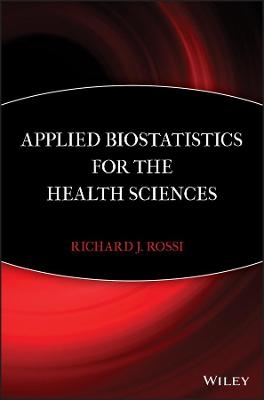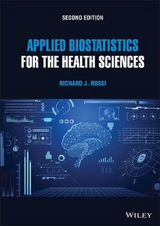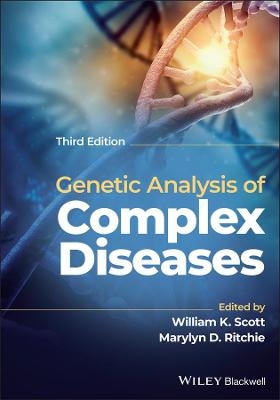
Applied Biostatistics for the Health Sciences
John Wiley & Sons Inc (Verlag)
978-0-470-14764-1 (ISBN)
- Titel erscheint in neuer Auflage
- Artikel merken
An authoritative, yet accessible, introduction to essential key methods used in the statistical analysis of data in the health sciences
Applied Biostatistics for the Health Sciences successfully introduces readers to the basic ideas and modeling approaches used in biostatistics through both step-by-step explanations and the use of data from the latest research in the fi eld. By focusing on the correct use and interpretation of statistics rather than computation, this book covers a wide range of modern statistical methods without requiring a high level of mathematical preparation.
The book promotes a primary emphasis on the correct usage, interpretation, and conceptual ideas associated with each presented concept. The author begins with a discussion of basic biostatistical methods used to describe sample data arising in biomedical or health-related studies. Subsequent chapters explore numerous modeling approaches used with biomedical and health care data, including simple and multiple regression, logistic regression, experimental design, and survival analysis. Combined with a focus on the importance of constructing and implementing well-designed sampling plans, the book outlines the importance of assessing the quality of observed data, collecting quality data, and using confi dence intervals in conjunction with hypothesis and signifi cance tests.
Composed of extensively class-tested material, the book contains numerous pedagogical features that assist readers with a complete understanding of the presented concepts. Key formulae, procedures, and defi nitions are highlighted in enclosed boxes, and a glossary at the end of each chapter reviews key terminology and ideas. Worked-out examples and exercises illustrate important concepts and the proper use of statistical methods using MINITAB® output, and the examples in each section showcase the relevance of the discussed topics in modern research. A related Web site houses all of the data related to the book's case studies and exercises.
Applied Biostatistics for the Health Sciences is an excellent introductory book for health science and biostatistics courses at the undergraduate and graduate levels. It is also a valuable resource for practitioners and professionals in the fields of pharmacy, biochemistry, nursing, health care informatics, and the applied health sciences.
RICHARD J. ROSSI, PHD, is Professor and Head of the Department of Mathematical Sciences at Montana Tech of the University of Montana. He has previously served as president of the Montana Chapter of the American Statistical Association (1996 and 2001) and as associate editor for Biometrics. Dr. Rossi has published journal articles in his areas of research interest, which include nonparametric density estimation, fi nite mixture models, and computational statistics. He is the author of Theorems, Corollaries, Lemmas, and Methods of Proof, also published by Wiley.
PREFACE xi
CHAPTER 1 INTRODUCTION TO BIOSTATISTICS 1
1.1 What is Biostatistics? 1
1.2 Populations, Samples, and Statistics 2
1.2.1 The Basic Biostatistical Terminology 3
1.2.2 Biomedical Studies 5
1.2.3 Observational Studies Versus Experiments 7
1.3 Clinical Trials 9
1.3.1 Safety and Ethical Considerations in a Clinical Trial 9
1.3.2 Types of Clinical Trials 10
1.3.3 The Phases of a Clinical Trial 11
1.4 Data Set Descriptions 12
1.4.1 Birth Weight Data Set 12
1.4.2 Body Fat Data Set 12
1.4.3 Coronary Heart Disease Data Set 12
1.4.4 Prostate Cancer Study Data Set 13
1.4.5 Intensive Care Unit Data Set 14
1.4.6 Mammography Experience Study Data Set 14
1.4.7 Benign Breast Disease Study 15
Glossary 17
Exercises 18
CHAPTER 2 DESCRIBING POPULATIONS 23
2.1 Populations and Variables 23
2.1.1 Qualitative Variables 24
2.1.2 Quantitative Variables 25
2.1.3 Multivariate Data 27
2.2 Population Distributions and Parameters 28
2.2.1 Distributions 29
2.2.2 Describing a Population with Parameters 33
2.2.3 Proportions and Percentiles 33
2.2.4 Parameters Measuring Centrality 35
2.2.5 Measures of Dispersion 38
2.2.6 The Coefficient of Variation 41
2.2.7 Parameters for Bivariate Populations 43
2.3 Probability 46
2.3.1 Basic Probability Rules 48
2.3.2 Conditional Probability 50
2.3.3 Independence 52
2.4 Probability Models 53
2.4.1 The Binomial Probability Model 54
2.4.2 The Normal Probability Model 57
2.4.3 Z Scores 63
Glossary 64
Exercises 65
CHAPTER 3 RANDOM SAMPLING 76
3.1 Obtaining Representative Data 76
3.1.1 The Sampling Plan 78
3.1.2 Probability Samples 78
3.2 Commonly Used Sampling Plans 80
3.2.1 Simple Random Sampling 80
3.2.2 Stratified Random Sampling 84
3.2.3 Cluster Sampling 86
3.2.4 Systematic Sampling 88
3.3 Determining the Sample Size 89
3.3.1 The Sample Size for a Simple Random Sample 89
3.3.2 The Sample Size for a Stratified Random Sample 93
3.3.3 Determining the Sample Size in a Systematic Random Sample 99
Glossary 100
Exercises 102
CHAPTER 4 SUMMARIZING RANDOM SAMPLES 109
4.1 Samples and Inferential Statistics 109
4.2 Inferential Graphical Statistics 110
4.2.1 Bar and Pie Charts 111
4.2.2 Boxplots 114
4.2.3 Histograms 120
4.2.4 Normal Probability Plots 126
4.3 Numerical Statistics for Univariate Data Sets 129
4.3.1 Estimating Population Proportions 129
4.3.2 Estimating Population Percentiles 136
4.3.3 Estimating the Mean, Median, and Mode 137
4.3.4 Estimating the Variance and Standard Deviation 143
4.3.5 Linear Transformations 148
4.3.6 The Plug-in Rule for Estimation 151
4.4 Statistics for Multivariate Data Sets 153
4.4.1 Graphical Statistics for Bivariate Data Sets 154
4.4.2 Numerical Summaries for Bivariate Data Sets 156
4.4.3 Fitting Lines to Scatterplots 161
Glossary 163
Exercises 166
CHAPTER 5 MEASURING THE RELIABILITY OF STATISTICS 181
5.1 Sampling Distributions 181
5.1.1 Unbiased Estimators 183
5.1.2 Measuring the Accuracy of an Estimator 184
5.1.3 The Bound on the Error of Estimation 186
5.2 The Sampling Distribution of a Sample Proportion 187
5.2.1 The Mean and Standard Deviation of the Sampling Distribution of 187
5.2.2 Determining the Sample Size for a Prespecified Value of the Bound on the Error Estimation 190
5.2.3 The Central Limit Theorem for 191
5.2.4 Some Final Notes on the Sampling Distribution of 192
5.3 The Sampling Distribution of 193
5.3.1 The Mean and Standard Deviation of the Sampling Distribution of 193
5.3.2 Determining the Sample Size for a Prespecified Value of the Bound on the Error Estimation 196
5.3.3 The Central Limit Theorem for 197
5.3.4 The t Distribution 199
5.3.5 Some Final Notes on the Sampling Distribution of 201
5.4 Comparisons Based on Two Samples 202
5.4.1 Comparing Two Population Proportions 203
5.4.2 Comparing Two Population Means 209
5.5 Bootstrapping the Sampling Distribution of a Statistic 215
Glossary 218
Exercises 219
CHAPTER 6 CONFIDENCE INTERVALS 229
6.1 Interval Estimation 229
6.2 Confidence Intervals 230
6.3 Single Sample Confidence Intervals 232
6.3.1 Confidence Intervals for Proportions 233
6.3.2 Confidence Intervals for a Mean 236
6.3.3 Large Sample Confidence Intervals for μ 237
6.3.4 Small Sample Confidence Intervals for μ 238
6.3.5 Determining the Sample Size for a Confidence Interval for the Mean 241
6.4 Bootstrap Confidence Intervals 243
6.5 Two Sample Comparative Confidence Intervals 244
6.5.1 Confidence Intervals for Comparing Two Proportions 244
6.5.2 Confidence Intervals for the Relative Risk 249
Glossary 252
Exercises 253
CHAPTER 7 TESTING STATISTICAL HYPOTHESES 265
7.1 Hypothesis Testing 265
7.1.1 The Components of a Hypothesis Test 265
7.1.2 P-Values and Significance Testing 272
7.2 Testing Hypotheses about Proportions 276
7.2.1 Single Sample Tests of a Population Proportion 276
7.2.2 Comparing Two Population Proportions 282
7.2.3 Tests of Independence 287
7.3 Testing Hypotheses about Means 295
7.3.1 t-Tests 295
7.3.2 t-Tests for the Mean of a Population 298
7.3.3 Paired Comparison t-Tests 302
7.3.4 Two Independent Sample t-Tests 307
7.4 Some Final Comments on Hypothesis Testing 313
Glossary 314
Exercises 315
CHAPTER 8 SIMPLE LINEAR REGRESSION 333
8.1 Bivariate Data, Scatterplots, and Correlation 333
8.1.1 Scatterplots 333
8.1.2 Correlation 336
8.2 The Simple Linear Regression Model 340
8.2.1 The Simple Linear Regression Model 341
8.2.2 Assumptions of the Simple Linear Regression Model 343
8.3 Fitting a Simple Linear Regression Model 344
8.4 Assessing the Assumptions and Fit of a Simple Linear Regression Model 347
8.4.1 Residuals 348
8.4.2 Residual Diagnostics 348
8.4.3 Estimating σ and Assessing the Strength of the Linear Relationship 355
8.5 Statistical Inferences based on a Fitted Model 358
8.5.1 Inferences about β0 359
8.5.2 Inferences about β1 360
8.6 Inferences about the Response Variable 363
8.6.1 Inferences About μY|X 363
8.6.2 Inferences for Predicting Values of Y 365
8.7 Some Final Comments on Simple Linear Regression 366
Glossary 369
Exercises 371
CHAPTER 9 MULTIPLE REGRESSION 383
9.1 Investigating Multivariate Relationships 385
9.2 The Multiple Linear Regression Model 387
9.2.1 The Assumptions of a Multiple Regression Model 388
9.3 Fitting a Multiple Linear Regression Model 390
9.4 Assessing the Assumptions of a Multiple Linear Regression Model 390
9.4.1 Residual Diagnostics 394
9.4.2 Detecting Multivariate Outliers and Influential Observations 399
9.5 Assessing the Adequacy of Fit of a Multiple Regression Model 401
9.5.1 Estimating σ 401
9.5.2 The Coefficient of Determination 401
9.5.3 Multiple Regression Analysis of Variance 403
9.6 Statistical Inferences-Based Multiple Regression Model 406
9.6.1 Inferences about the Regression Coefficients 406
9.6.2 Inferences about the Response Variable 408
9.7 Comparing Multiple Regression Models 410
9.8 Multiple Regression Models with Categorical Variables 413
9.8.1 Regression Models with Dummy Variables 415
9.8.2 Testing the Importance of Categorical Variables 418
9.9 Variable Selection Techniques 421
9.9.1 Model Selection Using Maximum R2adj 422
9.9.2 Model Selection using BIC 424
9.10 Some Final Comments on Multiple Regression 425
Glossary 427
Exercises 429
CHAPTER 10 LOGISTIC REGRESSION 446
10.1 Odds and Odds Ratios 447
10.2 The Logistic Regression Model 450
10.2.1 Assumptions of the Logistic Regression Model 452
10.3 Fitting a Logistic Regression Model 454
10.4 Assessing the Fit of a Logistic Regression Model 456
10.4.1 Checking the Assumptions of a Logistic Regression Model 456
10.4.2 Testing for the Goodness of Fit of a Logistic Regression Model 458
10.4.3 Model Diagnostics 459
10.5 Statistical Inferences Based on a Logistic Regression Model 465
10.5.1 Inferences about the Logistic Regression Coefficients 465
10.5.2 Comparing Models 467
10.6 Variable Selection 470
10.7 Some Final Comments on Logistic Regression 473
Glossary 474
Exercises 476
CHAPTER 11 DESIGN OF EXPERIMENTS 487
11.1 Experiments versus Observational Studies 487
11.2 The Basic Principles of Experimental Design 490
11.2.1 Terminology 490
11.2.2 Designing an Experiment 491
11.3 Experimental Designs 493
11.3.1 The Completely Randomized Design 495
11.3.2 The Randomized Block Design 498
11.4 Factorial Experiments 500
11.4.1 Two-Factor Experiments 502
11.4.2 Three-Factor Experiments 504
11.5 Models for Designed Experiments 506
11.5.1 The Model for a Completely Randomized Design 506
11.5.2 The Model for a Randomized Block Design 508
11.5.3 Models for Experimental Designs with a Factorial Treatment Structure 509
11.6 Some Final Comments of Designed Experiments 511
Glossary 511
Exercises 513
CHAPTER 12 ANALYSIS OF VARIANCE 520
12.1 Single-Factor Analysis of Variance 521
12.1.1 Partitioning the Total Experimental Variation 523
12.1.2 The Model Assumptions 524
12.1.3 The F-test 527
12.1.4 Comparing Treatment Means 528
12.2 Randomized Block Analysis of Variance 533
12.2.1 The ANOV Table for the Randomized Block Design 534
12.2.2 The Model Assumptions 536
12.2.3 The F-test 538
12.2.4 Separating the Treatment Means 539
12.3 Multifactor Analysis of Variance 542
12.3.1 Two-factor Analysis of Variance 542
12.3.2 Three-factor Analysis of Variance 550
12.4 Selecting the Number of Replicates in Analysis of Variance 555
12.4.1 Determining the Number of Replicates from the Power 555
12.4.2 Determining the Number of Replicates from D 556
12.5 Some Final Comments on Analysis of Variance 557
Glossary 558
Exercises 559
CHAPTER 13 SURVIVAL ANALYSIS 575
13.1 The Kaplan–Meier Estimate of the Survival Function 576
13.2 The Proportional Hazards Model 582
13.3 Logistic Regression and Survival Analysis 586
13.4 Some Final Comments on Survival Analysis 588
Glossary 589
Exercises 590
REFERENCES 599
APPENDIX A 605
PROBLEM SOLUTIONS 613
INDEX 643
| Erscheint lt. Verlag | 15.1.2010 |
|---|---|
| Zusatzinfo | Charts: 2 B&W, 0 Color; Drawings: 4 B&W, 0 Color; Screen captures: 25 B&W, 0 Color; Graphs: 171 B&W, 0 Color |
| Verlagsort | New York |
| Sprache | englisch |
| Maße | 185 x 260 mm |
| Gewicht | 1261 g |
| Einbandart | gebunden |
| Themenwelt | Mathematik / Informatik ► Mathematik ► Wahrscheinlichkeit / Kombinatorik |
| Studium ► 2. Studienabschnitt (Klinik) ► Humangenetik | |
| Studium ► Querschnittsbereiche ► Epidemiologie / Med. Biometrie | |
| ISBN-10 | 0-470-14764-4 / 0470147644 |
| ISBN-13 | 978-0-470-14764-1 / 9780470147641 |
| Zustand | Neuware |
| Informationen gemäß Produktsicherheitsverordnung (GPSR) | |
| Haben Sie eine Frage zum Produkt? |
aus dem Bereich



